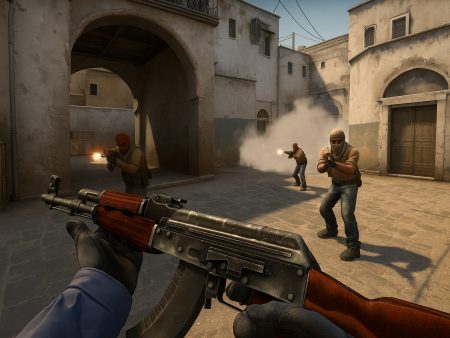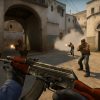Master the CS2 Anubis map with this ultimate guide covering detailed callouts, pro tips, utility lineups, and winning strategies for both T and CT sides. Perfect for ranked and competitive play.
Anubis is a competitive map in Counter-Strike 2 that brings an Egyptian-inspired battleground to the classic T vs CT format. Introduced initially as a community-made map, Anubis rose in popularity due to its unique architecture, verticality, and intricate lane designs. Eventually, it was added to the Active Duty map pool, replacing Dust II and shaking up the pro meta. Anubis isn’t just visually distinct—it challenges players with tight angles, complex mid control, and layered bomb sites that demand deep map knowledge.
What makes Anubis especially compelling is its multi-level design and strategic depth. Unlike maps such as Mirage or Inferno that offer more predictable pacing, Anubis rewards creativity and timing. Players can outmaneuver their opponents using silent walkways, unexpected boosts, and precise utility. Whether you’re lurking through canals or anchoring A site, success on Anubis comes down to how well you understand its callouts, choke points, and rotations.
Another standout feature is its asymmetrical design. The T side has multiple points of entry for both bomb sites, and the CT side has to coordinate closely to avoid getting split through mid or overwhelmed by a fast push. In this guide, we’ll explore how to master every element of Anubis, from basic callouts to pro-level strats.
The Importance of Map Knowledge
Let’s be real—if you don’t know the map, you’re basically running blind. On Anubis, this is even more critical because it’s relatively new to many players. Without clear knowledge of the map layout and callouts, your communication, positioning, and utility usage will all suffer. That means lost rounds, tilted teammates, and missed opportunities.
Understanding the map goes beyond just knowing where the bomb sites are. You need to be familiar with every corner where enemies might hide, every pathway that connects the lanes, and every trick spot where you can gain a split-second advantage. Anubis has lots of nooks and crannies—tight choke points, water-filled tunnels, bridges, and elevated walkways that can be used for sneaky plays.
Memorizing callouts is your first step. That way, when a teammate calls “One pushing Pit!” or “They’re flooding Mid Bridge,” you know exactly where to aim or throw your utility. We’ll break down every key area and provide callouts you and your squad can use for clean communication. Remember, your aim might win you a duel, but your map knowledge wins you the game.
General Overview of Anubis
Layout and Design of the Map
Anubis is a relatively medium-sized map but feels larger due to its vertical elements and interconnected mid area. It’s symmetrical at first glance, but the way it flows gives each side unique advantages and weaknesses. The CT side spawns near A and B sites, with quick access to both, while the T side has multiple paths to enter mid, A main, or B long.
Let’s simplify the layout:
- T Spawn: Connects to A Main, Mid, and B Long via quick splits.
- Mid: Central point of contest. Whoever controls Mid often controls the pace of the round.
- A Site: Tight angles and verticality (especially A Heaven).
- B Site: Wide open, ideal for smokes and post-plants.
- Canals: An underwater passage that can be used for sneaky rotations or split pushes.
Because the mid is a vital area, you’ll see a lot of early aggression here—both from Ts trying to gain control and CTs looking to shut them down. The layout rewards players who understand spacing, off-angles, and utility coordination.
Understanding the Theme and Aesthetic
Anubis is inspired by ancient Egyptian architecture, and it shows. You’ll fight in sandstone ruins, wade through shallow waters, and peek from intricate stone corridors. But this theme isn’t just cosmetic—it actually affects gameplay. For instance, the water in canals makes noise when you walk or run, which means even footsteps can give away your position.
The map’s verticality, combined with tight hallways and open bomb sites, makes it a hybrid between tactical and fast-paced gameplay. The visuals are also distinct, helping players quickly learn areas based on visual cues. For example, the golden pillars of A Heaven or the greenish-blue tones in Canals act as visual indicators for better map orientation.
Overall, the aesthetic supports gameplay fluidity, which is a rarity in many maps. Every texture and structure has gameplay relevance—from the boost boxes in Mid to the half-wall near B Connector.
CT vs T Side Dynamics
Now, let’s talk about balance. Is Anubis T-sided or CT-sided? The truth is, it depends on the coordination of the team. On paper, Anubis leans slightly T-sided because of the multiple access points and split options. However, CTs who know how to control mid and use utility effectively can shut down rushes and delay pushes long enough for reinforcements.
T Side Advantages:
- Multiple entry points make fakes easier.
- Fast access to mid means early control.
- Lurkers thrive due to many flanking routes.
CT Side Strengths:
- Quick rotations from spawn to both sites.
- Tight choke points ideal for holding with rifles.
- Strong off-angles on A and B sites.
The dynamic shifts based on your team’s ability to communicate and trade efficiently. If your CT side loses mid control early, expect a tough round. If you’re T and fail to use utility or overcommit to one site, CTs can retake easily. Strategy always trumps raw aim on Anubis.
All Key Callouts on Anubis
A Site Callouts
A Site is one of the most tactically rich areas on Anubis. It’s a compact bombsite with vertical layers, tight corners, and limited cover, making it perfect for crossfires and sneaky post-plant positions. Mastering the callouts here will significantly boost your communication and site control.
Here are the key callouts for A Site:
- A Main – This is the primary entry point for Ts attacking the A site. It’s a long corridor that leads directly into the site, with minimal cover. CTs often hold this angle from A Heaven or behind cover inside the site.
- A Site – The bomb plant zone itself. It includes multiple boxes and small cover spots. Smokes and flashes are crucial when executing or retaking this area.
- A Heaven – An elevated balcony above A Site, accessible by CTs. It’s a power position for AWPers or riflers who want a top-down view of the action. It’s also a common post-plant worry for Ts.
- A Pit – A lower ground area beside the site, often used by Ts to lurk or hide after planting. Pit control can win or lose post-plant scenarios.
Other notable micro-callouts include:
- Close Left/Right – These are cheeky hold spots as you push through A Main. Always check them with a flash or a pre-fire.
- Boost Box – There’s a boostable box that gives Ts or CTs a slight elevation for off-angles or spotting mid transitions.
- A Ramp – The sloped entrance into the site from A Main.
Effective coordination is vital on A. CTs typically play one in Pit or Close with a Heaven support, while Ts can set up a deadly crossfire by splitting through Mid Bridge and A Main. Utilize smokes for Heaven and flashes into Pit before pushing.
Mid Control Callouts
Mid is the heartbeat of Anubis. Control it, and you can split either site, catch rotates, or fake convincingly. The battle for mid often determines round outcomes, especially at higher skill levels. It’s also a hub for transitions and flanks.
Key mid callouts include:
- Top Mid – The entrance to mid from the T side. CTs often hold this with early utility, while Ts must be cautious of AWPs or early aggression.
- Mid Bridge – This wooden bridge spans over the water canal and connects to both bomb sites. Controlling this area allows Ts to split A or B.
- Mid Doors – These are double doors on the CT side of mid. CTs often play close behind them or use them to push mid for a quick flank.
- Water/Canals – The lower portion under the bridge, filled with shallow water. Movement here is audible, so it’s risky but effective for surprise flanks or rotations.
Mid can be attacked in several ways:
- Mid to A Split – Send players through Bridge into A Heaven or A Site while others come from A Main.
- Mid to B Connector – A powerful route if you smoke Mid Doors and flash into B Connector.
Tips for mid control:
- Use a molotov on Mid Doors to prevent CTs from peeking early.
- Flash over the bridge to blind AWPs or riflers.
- Communicate fast rotations if CTs push mid aggressively.
B Site Callouts
B Site is more open than A, allowing for strong utility usage and quick entries. It’s also a favorite site for Ts due to easier access and more planting options.
Key callouts for B Site:
- B Main – This is the primary path into B from the T side. It’s wide and has limited cover, making it essential to use smokes and flashes.
- B Long – A flanking lane that wraps around the back of the site. Often used by lurkers or late-round rotators.
- B Site – The bomb zone, which is more exposed than A. It includes some pillars and boxes for cover.
- B Connector – A hallway that links Mid to B Site. Ts often use this route during a Mid-B split. CTs can also rotate through here.
Additional micro-positions:
- Default – The common bomb plant location.
- Pillar – A large stone structure in the middle of B Site used for cover.
- Back Site – A deep corner CTs often hold from, useful for delaying rushes or setting up post-plant retakes.
Executing B requires coordination:
- Smoke B Heaven or Back Site to limit vision.
- Flash B Main to blind holding CTs.
- Post-plant, hold from B Main or B Long to cover defuses.
T-Side Strategies on Anubis
Early Round Mid Control
As a T, taking early control of mid on Anubis opens up endless possibilities. Mid connects to both bomb sites and allows for effective split strategies, but it’s also hotly contested by CTs. If you control mid, you dictate the flow of the round.
How to take mid control:
- Smokes: Drop a smoke at Mid Doors to block vision from CTs pushing or AWPing from deep mid.
- Flashes: Flash over Mid Bridge and Canals to blind potential CT peekers.
- Molotovs: Use mollies to clear close corners under the bridge or near the connector.
Once you’ve established mid presence, you can choose to:
- Split A by pushing through Bridge into Heaven.
- Collapse B via B Connector while teammates push B Main.
- Fake pressure mid, then regroup and explode onto A or B.
Timing is everything. A successful mid take often forces CTs to rotate or overextend, giving you opportunities for picks or a site take. Keep communication tight and always trade out kills.
A Split Executions
The A Split is one of the most effective executes on Anubis. It involves pushing from both A Main and Mid Bridge, squeezing the defenders on site from multiple angles.
Setup:
- 2 Ts enter from A Main with smokes for Heaven and flashes into site.
- 2 Ts push Mid to Bridge and drop into Heaven or Pit.
- 1 lurker watches for pushes or rotates from B.
Key smokes:
- Heaven Smoke (blocks off sniper sightlines).
- A Site Cross Smoke (allows entry from A Main without exposure).
Execution tips:
- Time your push so that A Main and Bridge attackers enter simultaneously.
- Watch for CTs playing close on Pit or behind site boxes.
- Molotov common CT hiding spots.
Once the bomb is planted, fall back to Pit and Heaven for powerful post-plant control. Use sound cues from water or mid to predict flanks.
B Rush and Fake Strats
If you’re facing a passive CT team or trying to disrupt their economy, a B rush can be devastating. It’s also effective as part of a conditioning strategy—rush B for a few rounds, then fake and rotate to A.
B Rush:
- 4 Ts rush B Main with smokes and flashes.
- 1 lurker fakes A or watches mid.
Fake B, Go A:
- Throw utility at B Main to suggest a push.
- Send 1 player to make noise.
- Rest of the team quietly rotates through Mid to A.
Execution essentials:
- Use early flashes to blind B Main defenders.
- Molotov common spots like Pillar and Back Site.
- Plant quickly and take strong post-plant angles.
Faking B can also pull CTs off mid or A, allowing for safer splits or rotations.
CT-Side Strategies on Anubis
Aggressive Mid Push
While Ts often dominate mid on Anubis, a calculated CT mid push can completely disrupt their round. Mid aggression from CTs should be used sparingly but with purpose—it’s all about timing and coordination.
When to push mid as CT:
- After reading passive T defaults.
- To deny early map control and delay their setup.
- When you need to gain information for stack rotations.
How to do it:
- One CT mollies T Mid entrance or Top Mid to slow down early pushes.
- One AWPer holds from Mid Doors or Canals to catch peeks.
- A rifler pushes close to Bridge and holds a tight angle or sets up for a surprise peek.
Advantages of mid push:
- Disrupts T-side economy and strategy.
- Can lead to early picks and map control.
- Opens up opportunities to flank or collapse on executing Ts.
Cautions:
- Always have support or a trade setup.
- Avoid getting isolated or overwhelmed by a fast T mid rush.
- Use smokes or flashes to safely retreat if the push fails.
Done right, this strategy turns mid into a CT stronghold and forces Ts to change their approach.
Standard A and B Site Holds
Let’s break down how to hold each site effectively as a CT.
A Site Hold:
- One player Pit: Great for stopping fast entries and playing retake.
- One player Heaven: Controls long sightlines and covers A Main.
- Optional third player Mid/Bridge support: Rotates fast to assist A or stop splits.
Tips for A Hold:
- Use smokes to delay pushes from A Main.
- Drop molotovs into Pit or Main if you hear a rush.
- Fall back and wait for rotates if overwhelmed.
B Site Hold:
- One player Back Site or Default: Holds B Main push.
- One player B Connector or close water: Watches for mid splits or rotates.
Tips for B Hold:
- Place a smoke at B Main entrance to delay rushes.
- Flash over site for peeking teammates.
- B site has less verticality, so holding angles is easier.
Both sites benefit from quick rotations through Mid or Canals, so make sure one player anchors and the other can rotate or support mid.
Rotations and Flank Management
Rotations on Anubis are tricky because of the map’s interconnected lanes and sound cues. A poor rotate can lead to being caught mid-transition, while a well-timed flank can turn the round in your favor.
Best rotate paths:
- CT to A via Heaven: Fast and safe.
- CT to B via B Connector or Canals: Takes longer but gives good angles.
- Mid Rotate via Bridge: Risky but can catch Ts off-guard.
Flank tips:
- If you control mid, use Canals to flank Ts holding post-plant from Main.
- Use silent walk through water or bridge to avoid audio cues.
- Have one player constantly aware of the minimap to call out rotate timings.
Smart CTs don’t over-rotate. They wait for info, use utility to stall, and rotate as a team. Timing is key—rotate too early, and you get faked. Rotate too late, and the site is already lost.
Best Utility Usage Spots
Smokes for Key Choke Points
On Anubis, utility is everything. Because the map has long corridors and tight chokes, smokes can neutralize powerful sightlines and delay aggressive pushes.
T-Side Smokes:
- A Heaven Smoke (from A Main): Blocks off CTs from high ground.
- Mid Doors Smoke (from Top Mid): Prevents CTs from spotting or AWPing.
- B Back Site Smoke (from B Main): Forces site players into the open.
CT-Side Smokes:
- Mid Control Smoke (from Mid Doors): Denies info and slows pushes.
- A Main Smoke: Prevents quick A executes.
- B Main Smoke: Useful to stall or force Ts to rush through it.
Practice your lineup in offline maps or workshop servers to master these smokes. Good utility can win a round without firing a bullet.
Flashbangs for Entry and Retakes
Flashes make or break executes and retakes on Anubis. Used properly, they blind defenders or attackers at the right moment, giving you a crucial edge.
Entry Flash Spots:
- A Main Pop Flash: Bounces off the right wall to blind A Heaven and site.
- Mid Bridge Flash: Tossed over the bridge to blind anyone holding from Mid Doors or Canals.
- B Site Flash: Thrown from B Main to blind players near Pillar or Default.
Retake Flashes:
- Heaven Flash into A Site: For CTs retaking from Heaven.
- B Connector Flash into B Site: For CTs pushing from mid side.
Flashbangs require timing and team coordination. Don’t just throw and hope—communicate who’s flashing and when, then peek together.
Molotovs for Area Denial
Molotovs are perfect for flushing out hiding enemies and denying fast pushes. Anubis has several tight corners and hiding spots ideal for molly usage.
Key Molotov Spots:
- Pit Molotov (A Site): Clears common hiding spot.
- Bridge/Canal Molotov: Prevents Ts from rushing mid.
- B Pillar Molotov: Forces out CTs or Ts from a strong post-plant position.
Molotovs also create sound cues and panic. Use them before pushing to force movement or to delay enemies while rotating.
Common Mistakes to Avoid on Anubis
Overcommitting to One Site
One of the biggest mistakes players make—especially on the T-side—is overcommitting to a single bomb site too early without any information. Anubis punishes this with tight chokes and easy-to-defend angles, allowing just two well-placed CTs to hold off a full team push if utility is used poorly.
Why is this so critical?
- CT rotations are fairly fast, especially through Mid or Canals. So if you delay your push, defenders have time to rotate.
- Overcommitting gives CTs confidence to stack or gamble sites because your team becomes predictable.
- You lose the element of surprise. Once your smokes are deployed early, CTs can adjust positions and call for backup.
To fix this:
- Default more. Spread out early to gather information before committing.
- Use fakes wisely. A smoke and a couple of flashes can pull one or two CTs off a site.
- Don’t forget the clock. A late rotation can mean a rush plant or even a round loss due to time.
Balance aggression with discipline. Anubis is all about timing and deception.
Poor Mid Control
Mid control on Anubis is the foundation of any successful half—on either side. Ignoring it gives your opponents a free path to flank, split, or rotate safely, and you’ll constantly feel like you’re being pinched.
What happens when you ignore mid?
- On T side, you lose access to split options and force yourself into direct site pushes.
- On CT side, you open the map for Ts to rotate or fake with ease.
Mid must be actively contested or held. Letting it go without a fight is like giving up half the map. To improve:
- Use delayed utility. Even if you don’t contest mid early, you can still molly or flash it to delay Ts.
- Play crossfire setups in mid Bridge and Mid Doors.
- For Ts, send two players mid—one lurker and one support—who can quickly adapt.
Mastering mid gives you the keys to the entire map.
Lack of Utility Coordination
CS2 isn’t just about aim. Your utility matters even more—especially on a layered map like Anubis. Poorly coordinated smokes and flashes lead to awkward entries, bad post-plants, and isolated teammates.
Common utility errors:
- Throwing solo flashes without teammates peeking.
- Missing key smokes like Heaven or Mid Doors.
- Wasting molotovs on spots that aren’t being played.
Instead:
- Call out “I’m flashing” before you throw. That way, teammates are ready.
- Learn lineups and practice them in solo sessions.
- Use utility to create pressure. A molly at B Pillar might not get a kill, but it forces the enemy out of position.
Strong utility wins rounds even when your shots don’t land.
Tips to Improve Gameplay on Anubis
Communication and Callouts
Anubis requires tight team communication. With so many split routes, bridges, and elevations, staying silent is a death sentence.
How to improve:
- Stick to short, precise callouts. (“One Pit”, “Bridge dead”, “AWP Heaven”)
- Repeat important info twice. (“B main, B main!”)
- If you’re low or out of utility, say so.
Also, keep your mic clear. No rage, no blame—just focus on what’s happening. The team that communicates better usually comes out on top.
Practicing Pre-aim and Crosshair Placement
Anubis is full of awkward off-angles, tight corners, and elevation changes. Practicing your pre-aim and crosshair placement is essential.
Try these tips:
- Use workshop maps like “Yprac Anubis” or “Training_aim_csgo” to get muscle memory for peeking angles.
- Practice pre-aiming common spots like A Pit, Mid Doors, B Pillar.
- Adjust your crosshair height for ramps and water areas, where elevation can throw off your aim.
Good crosshair placement often gives you the advantage before the fight even starts.
Teamwork and Role Management
Teamwork > Solo heroics on Anubis.
Assign roles:
- Entry Fragger – Opens sites, first in.
- Support – Throws utility, trades.
- Lurker – Holds flanks, catches rotates.
- AWPer – Holds long angles like A Main or Mid.
- IGL – Calls the strat and rotations.
Don’t step over each other. If you’re support, focus on lining up flashes or molotovs, not getting the top frag. When each role works together, Anubis becomes a playground for creative team strategies.
Advanced Techniques and Strategies
Lurk Timing and Silent Walk Routes
Anubis has several paths perfect for lurking. You can silently move through Canals, creep up Mid Doors, or lurk through B Long for late-round picks.
Best lurk tips:
- Watch for sound traps like water.
- Walk through areas with high rotation frequency (e.g., Canals).
- Time your push right after your team makes noise on the other site.
The best lurks win rounds by confusing enemy rotations.
Off-Angle Holding Spots
Off-angles catch enemies off guard. Anubis has plenty:
- Mid Bridge railing – hold right side with one-way peek.
- A Heaven ledge – awkward but deadly off-angle.
- B Site pillar corner – a non-default hold that surprises entries.
Use off-angles sparingly. If you hold the same one every round, you’ll get pre-fired into oblivion.
Wallbangs and Nade Lineups
Yes, Anubis has wallbangs too.
- A Site boxes are spammable.
- Mid Doors to Top Mid through the wooden door can net early kills.
- B Site pillar and walls are partially wallbangable.
Use HE grenades at:
- Bridge (for early mid control)
- Pit (for default hiding Ts)
- Connector entrances
Mastering lineups puts you a step above your average ranked warrior.
Competitive Meta and Pro Tips
Pro Team Approaches to Anubis
Top-tier teams treat Anubis like chess. They:
- Take mid early, then fall back.
- Fake B with utility, then wrap A.
- Play heavy post-plant positions from water and Heaven.
Watch demos of teams like Vitality, NAVI, and FURIA to study how they rotate, when they push mid, and how they use utility together.
How to Adapt to the Meta
Keep your strats fresh. If you notice teams:
- Stacking A – start faking A and rotating B.
- Playing passive B – rush with flashes and overrun them.
Adaptation wins series. If one strat fails three rounds in a row, it’s time to change it up. Be unpredictable.
Learning from Demo Reviews
Want to truly improve?
Watch your own demos.
- See where you lost fights.
- Track your utility usage.
- Find missed timings or rotations.
Tools like CSGO Demo Manager or GOTV let you break down games round by round. It’s boring, but it works.
Conclusion
Anubis isn’t just another CS2 map—it’s a battlefield of brains, mechanics, and team synergy. Whether you’re anchoring A, rushing B, or fighting for mid control, the map demands adaptability and communication. Mastering callouts, refining utility usage, and learning the flow of the map can give you the edge you need in ranked or competitive play.
From faking with smokes to lurking through silent routes, Anubis rewards players who think two steps ahead. It might feel chaotic at first, but with this guide, you’re now armed with all the tools and tactics needed to dominate every round.
So get out there, load into Anubis, and start grinding. Victory isn’t given—it’s earned.
FAQs
What is the best site to push on Anubis as T?
It depends on your team’s playstyle, but B is generally easier to execute on due to wider entry points and fewer vertical angles. A requires more coordination and utility.
How do you take mid control effectively?
Use smokes for Mid Doors, molotov close corners under Bridge, and flash before pushing. Have two players—one holds while the other clears.
Which roles work best for holding B site?
A rifler in Default or Pillar and a rotator from Connector or Canals. Communication and timing are key to shutting down rushes or mid splits.
Are there any good one-way smokes on Anubis?
Yes, especially on A Heaven and near Mid Doors. Practice lineups in custom servers to gain an edge over opponents holding standard angles.
How do you rotate efficiently as CT on Anubis?
Use Mid Bridge or Canals based on where the Ts are executing. Don’t rotate too early—wait for confirmation or sound cues before committing.












